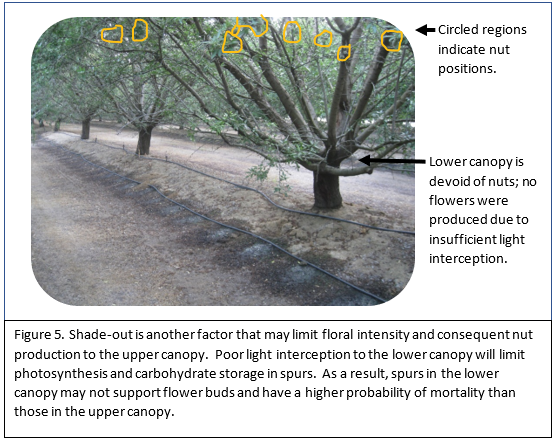Almond bloom intensity may be affected by prior year’s irrigation practices and diseases
E. Fichtner, UCCE Farm Advisor Tulare and Kings Counties
M. Culumber, UCCE Farm Advisor Fresno and Kings Counties
B. Lampinen, CE Specialist, UC Davis
Factors influencing a current year’s almond bloom intensity may have been initiated 9 months prior to bloom. In almond, bud development generally occurs in late spring (Figure 1). During the initial phase of bud development, vegetative and flower buds are all morphologically similar. In late summer, however, a portion of the buds will differentiate to form flower buds. Consequently, the physiological and pathological stresses exerted on almond trees the prior year may influence bloom and subsequent yield in the current year.
Orchards that are overwatered the prior year may exhibit low bloom intensity in the current year. A review of the prior year’s stem water potential records is the first step in assessing the potential influence of over-watering in suppression of subsequent bloom. Based on researcher observations, trees maintained either at or above (ie. wetter) the baseline tended to have lower bloom intensity the following year. The baseline value is the expected stem water potential of a fully-watered orchard. Baseline values vary depending on environmental conditions (temperature and relative humidity) and are specific for each crop. If stem water potential records are not available, observations of bloom distribution both within orchards and trees may elucidate the cause of current bloom irregularities.
Orchard-level observations. If bloom density at full bloom varies between rows of different varieties (forming a repeated pattern across the orchard) the prior year’s water status may have influenced flower bud development.
If an orchard is comprised of multiple varieties, the bloom intensity should be evaluated for each variety at full bloom, which will likely occur on different days. If a variety characterized by smaller trees exhibits lower bloom intensity than a variety with larger trees, it is likely that the smaller trees were over-irrigated the prior season. For example, an orchard planted with Monterey and Nonpareil may have lower bloom intensity in the Monterey rows than in the Nonpareil rows (Figure 2). The Monterey trees often tend to be smaller than the neighboring Nonpareil, and therefore receive more water per unit tree canopy than the Nonpareil. As a result, Monterey may be maintained at or above the baseline in an orchard where irrigation management is based on the water status and tree water requirements of Nonpareil.
Within-tree observations. If the bloom is concentrated at the top of the canopy (Figure 3), and flowering is sparse in the lower canopy, the orchard may have been overwatered the prior season. The water potential varies throughout the tree, with the increasingly negative gradient progressing sequentially from the soil, through the roots, stems, lower canopy, and upper canopy (Figure 3). The water potential in the upper tree canopy may have been conducive to floral bud production while the water potential in the lower canopy may have been too high (ie. too wet) to promote flower bud development.
Combination of orchard-level and tree-level observations. If bloom intensity appears to vary between rows in a pattern indicating differences between cultivars, with low bloom intensity occurring predominantly in the lower interior canopy, hull rot the prior year may be a contributing factor. Although the symptoms of hull rot are often noticed at harvest, the lasting effects of hull rot may go unnoticed until bloom and bud break the subsequent year. Rhizopus stolonifera is particularly responsible for producing a toxin (fumaric acid) that kills spurs and twigs (Figure 4) associated with infected nuts. Unlike slight over-irrigation the prior year, hull rot infections may result in acute spur mortality, resulting in destruction of both vegetative and floral buds. Susceptibility to the disease varies between cultivars, resulting in differential symptom development between rows. Nonpareil, Sonora, and Winters are all susceptible. Additionally, because hull rot is promoted by orchard moisture and humidity during hull split, the symptoms are more pronounced in the lower canopy (due to humidity) and the disease may have a synergistic effect with overwatering in reducing the following year’s bloom.
Another factor contributing to a preponderance of flower buds in the outer canopy of mature trees across orchards is shading related dieback (Figure 5). The probability of a spur setting a flower is related to previous year leaf area. For example, non-bearing spurs with a leaf area of › 50 cm2 have over an 80% probability of supporting flowers the following year. If light infiltration to the lower canopy is not sufficient to provide adequate carbohydrate storage in spurs, flowering potential in the lower canopy will be diminished. Over 80% of the nuts produced by a given tree are borne on spurs; consequently, any factor limiting photosynthesis in spurs will affect flowering potential.
The converse scenario. A heavy bloom in the current year may be related to a propensity of non-nut bearing spurs the prior year. Several factors may have contributed to low nut set the prior year, including: i) diseases at bloom (ie. blast or brown rot), ii) weak bee hives, iii) weather non-conducive to bee flight, and iv) frost during bloom. When nut set is low, spurs retain carbohydrate stores resulting in increased leaf area and an increased probability of flowering and setting a crop the following year.
Summary. If almond bloom at a given ranch appears irregular, assess potential causes by making detailed observations of the bloom patterns both within orchards and within individual trees. Also consider differences in bloom density between cultivars, being sure to make comparisons at the same time stage of bloom progression. Irrigation related records from the prior year may also provide clues for determining the potential for orchard water status to have influenced the bloom in the current year.





